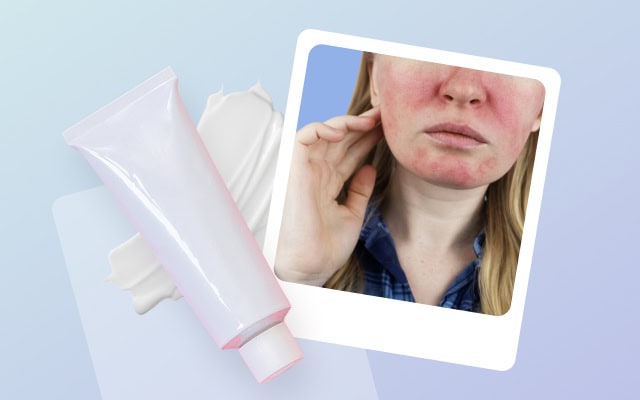What is the best seborrheic dermatitis face cream?
Dr. Ben Williams, dermatologist, explains the best seborrheic dermatitis face crams available and explains how you can secure a prescription.
Table of Content:
What is seborrheic dermatitis? | Symptoms | What causes it? | How to get a prescription? | Best face creams | Can you get it in your eyebrows? | FAQ
Our commitment to producing high-quality content:
The information presented in this article is based on scientific research and the professional advice of our Content Medical Reviewers, who are experts in the field of Dermatology. How we write our content →
What is facial seborrheic dermatitis?
Seborrheic dermatitis (also known as facial dandruff) is characterized by the presence of dry, flaky, and sometimes greasy, yellowish flakes on the skin. It is a common skin condition that tends to affect hair bearing areas of the face or scalp particularly the eyebrows, nose creases (nasolabial folds), behind the ears, middle of the chest, and commonly the beard area in men1.
Symptoms of facial seborrheic dermatitis
Flaky skin
One of the primary symptoms is the presence of small, white to yellowish flakes on the affected areas of the face. These flakes may resemble dandruff on the scalp.
Redness and inflammation
The affected skin areas may appear red, irritated, or inflamed. It can be accompanied by itching and discomfort. The aftermath of this can leave patients with hypopigmented or temporary lightening of the skin in the areas that were involved.
Greasy appearance
In some cases, facial dandruff may result in a greasy or oily appearance, especially in the eyebrows or around the nose.
Ring-shaped rash
In some cases a rash that is ring or “petal-shaped” may appear which is a variant that is referred to as “petaloid.”
Flare-ups
The condition may have periods of flare-ups and remission, with symptoms worsening in response to various triggers like stress, weather changes, or certain skincare products2.
What causes seborrheic dermatitis on the face?
Seborrheic dermatitis is typically caused by a combination of genetic predisposition and environmental influences. The primary trigger often involves an inflammatory response to an excess of Malassezia yeast, which is a naturally occurring microorganism on the skin’s surface. The overgrowth of Malassezia can trigger an exaggerated immune response, leading to a fungal infection and changes in the skin3.
Certain conditions (such as psoriasis, HIV, acne, rosacea, Parkinson’s disease, epilepsy, alcoholism, depression, eating disorders, and recovery from a stroke or heart attack) can also increase the likelihood of a person getting seborrheic dermatitis.
Common triggers for seborrheic dermatitis include:
- Stress
- Recovery from significant life stressors
- Excessive heat and sweat
- Hormonal fluctuations or illness
- Exposure to harsh detergents, soaps and skin care products
- Extreme hot/cold and dry weather conditions or seasonal changes4
Do I need a prescription for seborrheic dermatitis?
Seborrheic dermatitis on the face can be mistaken for a few other skin conditions, failing to have an adequate diagnosis and treatment can only worsen your symptoms which is why it is recommended having a consultation with a dermatologist to ensure that the skin problem you have is indeed seborrheic dermatitis and rule out anything else.
How to get a prescription for seborrheic dermatitis?
You can have a photo-consultation with an independent, board-certified dermatologist for only $59. You need to take some photos of your face, and answer a clinical questionnaire. In less than 48 hours a dermatologist will review your case, you will get the dermatologist’s treatment plan.
Secure, confidential, and reviewed by board-certified dermatologists.
What are the best seborrheic dermatitis face creams?
According to Dr. Williams, the best seborrheic dermatitis face treatment typically involves a combination of self-care measures, over-the-counter (OTC) products, and prescription medications, depending on the severity of the condition.
First-line treatments for facial seborrheic dermatitis
Antifungal creams and shampoos
Antifungal creams (such as ketoconazole, ciclopirox, or clotrimazole) are effective in treating seborrheic dermatitis when the condition is associated with yeast overgrowth. Ketoconazole is clinically proven and widely used for this condition and it is part of the reason we understand seborrhea’s relation to yeast. Ketoconazole 1% shampoos can be found over the counter in brands such as Nizoral.
Topical calcineurin inhibitors
Topical calcineurin inhibitors (such as tacrolimus and pimecrolimus) are a class of medications used to treat various inflammatory skin conditions, especially those involving the immune system. These medications are applied directly to the skin and work by inhibiting the activity of calcineurin, an enzyme involved in immune system function. Unlike topical steroids, these do not carry the risk of skin atrophy.
Used cautiously or second-line seborrheic dermatitis on the face
Topical corticosteroids
Topical steroids (such as hydrocortisone, mometasone, desonide) are prescribed by dermatologists to help reduce redness, itching, and inflammation in the skin associated with seborrheic dermatitis. Topical steroid use on the face must be used with caution considering the increased risk of side effects such as steroid atrophy or thinning of the skin with long-term consistent use.
Less preferred for facial use
Coal tar
Coal tar creams, shampoos and ointments are used for the treatment of seborrheic dermatitis, psoriasis, or sebo-psoriasis on the scalp because they can help reduce itching and inflammation. These are found over the counter.
Oral medications
In severe or resistant cases of seborrheic dermatitis on the face, a dermatologist may recommend oral medications, such as oral antifungal agents.
These prescription medications are typically reserved for more severe cases and require close medical supervision due to potential side effects.
Secure, confidential, and reviewed by board-certified dermatologists.
Tips to help manage seborrheic dermatitis symptoms
Use a mild cleanser
Use luke-warm water and a gentle, fragrance-free, and hypoallergenic facial cleanser to wash your face. We recommend gentle skin cleansers such as “foams” for oily skin and “hydrating formulas” for drier skin types. Avoid using hot water and harsh soaps or cleansers that can strip the skin of its natural oils and exacerbate dryness. Many people who do not regularly bathe or wash their hair suffer from this condition simply because the yeast do not get removed regularly enough from the skin from gentle cleanser and water.
Moisturize your face
Apply a fragrance-free,hypoallergenic moisturizer to your face regularly to keep the skin hydrated. Look for products that are suitable for sensitive or dry skin. Sometimes the dry flaking is not yeast driven and is simply from xerosis of the skin aka dryness; however, a dermatologist should be able to make this distinction usually based on location and appearance. A real world example of this would be fine white scaling in the scalp that is worsened by ketoconazole shampoo since it by itself is very drying, but rather the scaling usually accompanied by itching actually improves with an emollient such as argan oil.
Apply sunscreen
Use a broad-spectrum sunscreen with an SPF of 30 or higher as sunburn can cause or worsen facial dandruff by further compromising the skin barrier.
Exfoliate your skin
Gently exfoliate your face with a product containing salicylic or lactic acid to remove dead skin cells and flakes especially when thick greasy, yellow scaling is present.
Use gentle skin care products
Use skin care products that are suitable for sensitive skin.
Use stress management techniques
Stress can contribute to skin issues, including seborrheic dermatitis. Engage in stress-reduction techniques such as meditation, yoga, or deep breathing exercises.
Maintain a healthy diet
Maintain a balanced diet rich in nutrients, including omega-3 fatty acids and antioxidants, which can support overall skin health.
Make some lifestyle adjustments
Adjusting your lifestyle to get enough sleep, drink at least 8 glasses of water per day to stay hydrated, avoid the use of tobacco, and drink alcohol moderately.
FAQ about seborrheic dermatitis
Can you get seborrheic dermatitis in your eyebrows?
Yes, in fact this is one of the most common locations to get seborrheic dermatitis.
Here are some tips from Dr. Williams to help you manage it:
- Cleanse the whole face gently using a mild, gentle skin cleanser such as Cerave Foaming wash. Dr Williams recommends foaming washes assuming most patients with seborrheic dermatitis are on the more oily than dry side of skin types but this is not always the case. You want to cleanse your face at least once per day and if possible both morning and night as this will aid in removing excess yeast from the skin. If scaling is present, you can use either a gentle exfoliant three times weekly or consider adding a salicylic acid wash to use at night in place of the gentle skin cleanser. However, I would still use the gentle skin cleanser in the mornings.
- Another alternative approach is using ketoconazole shampoo as both a shampoo and a face wash. When the skin is flaring, Dr. Williams recommends daily use. When the maintenance phase is achieved, he recommends using this 2-3x weekly even when the skin is totally clear in order to keep the overall yeast burden low. When you are using this shampoo, you should apply it to all areas and sud them up while avoiding the eyes. Step back from shower water and leave this on skin for 3-5 minutes before rinsing completely. Seborrheic dermatitis is a chronic condition and requires lifelong maintenance treatment in most cases.
- Once the area is cleansed, apply antifungal cream or topical anti-inflammatory medications as prescribed and recommended by your doctor.
If you do not notice any improvement in your symptoms, you should consult a dermatologist. They may prescribe medicated ointments or creams containing steroids, antibiotics, or antifungal agents to address the underlying cause of eyelash dandruff.
Can you get seborrheic dermatitis in your beard?
Yes, you can get seborrheic dermatitis in your beard, this condition is also referred to as beard dandruff. Since a cream is quite difficult to rub into a beard, Dr. Williams usually recommends using the ketoconazole shampoo to be used as a facial wash and rubbing an ointment such as tacrolimus.
Can you get seborrheic dermatitis in the scalp?
Yes, you can get seborrheic dermatitis in your scalp, this condition is usually referred to as dandruff. Learn more about the best treatments for scalp dandruff.
Is cradle cap seborrheic dermatitis?
Yes, cradle cap (also called infant seborrheic dermatitis) is a common and harmless skin condition that affects babies, causing yellow or white scaly patches on the scalp. It typically appears within the first year of life but often resolves on its own within a few weeks or months. This condition does not cause discomfort, itching, or pain for the baby and most cases do not require treatment, but gentle at-home care can help remove the scales.
Is seborrheic dermatitis contagious?
Seborrheic dermatitis, like all other forms of eczema, is not contagious and cannot be transmitted from one person to another.
Can seborrheic dermatitis cause hair loss?
According to Dr. Williams, seborrheic dermatitis typically does not directly cause hair loss. However, in some cases, without adequate treatment the inflammation and excessive itching associated with seborrheic dermatitis may lead to hair loss indirectly.
What is the best cream for seborrheic dermatitis?
According to Dr. Williams, if your dermatologist has diagnosed you with seborrheic dermatitis, they may prescribe a combination of anti-fungal creams, topical calcineurin inhibitors and in some cases topical corticoids.
The takeaway
Seborrheic dermatitis can affect various areas of the body, including the face, scalp, eyebrows, and even the beard. The best treatment involves a combination of self-care measures, over-the-counter (OTC) products, and prescription medications, depending on the condition’s severity.
Medications like topical corticosteroids, coal tar products, antifungal creams, and topical calcineurin inhibitors are commonly used to manage facial symptoms. In severe cases, oral medications may be necessary but require close medical supervision due to potential side effects.
It’s worth noting that some of these medications widely used to treat seborrheic dermatitis are also used to treat spongiotic dermatitis, another inflammatory skin condition. If you want to learn more about spongiotic dermatitis and the best treatment options, we invite you to read our in-depth article “Spongiotic Dermatitis: What is it and what is the best treatment?“
Lee éste artículo en Español ¿Qué es la dermatitis seborreica y cuál es el mejor tratamiento?
Provider & Prescription Information
Miiskin connects patients with independent dermatologists who provide care through their private practices. Compounded prescriptions can be ordered via Miiskin and are dispensed by Foothills pharmacy. Standard medications can be issued for any local pharmacy.
Article References:
https://www.mayoclinic.org/diseases-conditions/seborrheic-dermatitis/symptoms-causes/syc-20352710
https://nationaleczema.org/eczema/types-of-eczema/seborrheic-dermatitis/
https://www.mayoclinic.org/diseases-conditions/seborrheic-dermatitis/diagnosis-treatment/drc-20352714#
https://pubmed.ncbi.nlm.nih.gov/15663338/
https://www.hmpgloballearningnetwork.com/site/thederm/article/3675
https://my.clevelandclinic.org/health/diseases/15786-cradle-cap-seborrheic-dermatitis-in-infants
Skin conditions and treatments
Articles reviewed by dermatologists
Facial treatment for seborrheic dermatitis
How to get rid of rosacea permanently?
How to calm a rosacea flare-up fast?
Spongiotic dermatitis: What is it and what is the best treatment?





 Still dealing with skin issues? Get expert help from home.
Still dealing with skin issues? Get expert help from home.